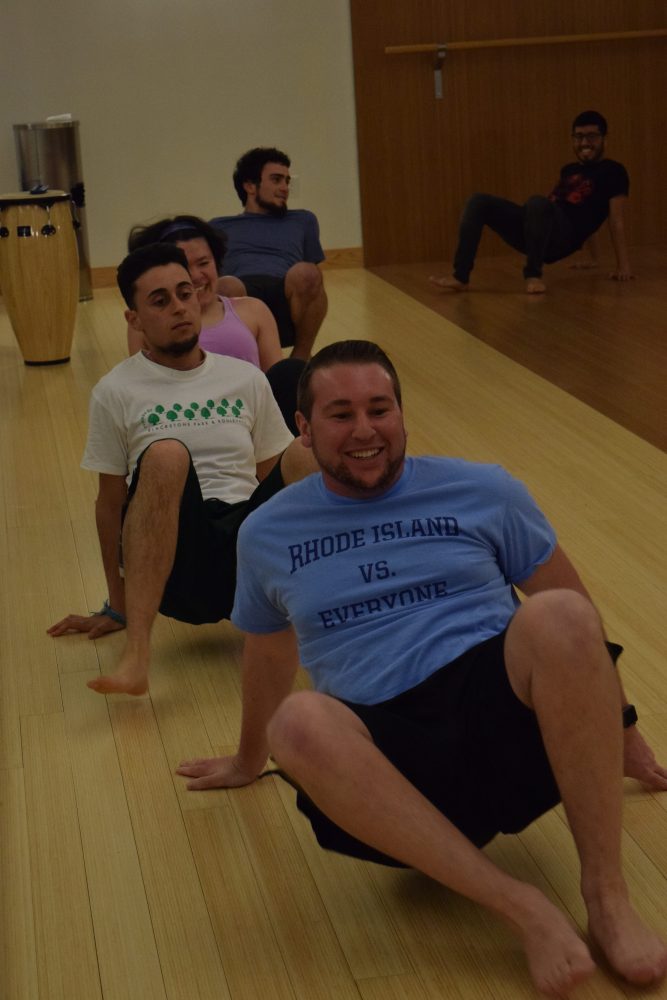Photo by Joe Lachance |CIGAR| Sam opens himself up to new experiences in his class, learning skills and pushing himself even further.
Samuel Murray does capoeira
There are many different types of martial arts that it could fill its own dictionary. Some, like Karate, hail from Eastern Asia and rely on quick skill and strikes. Others, like wrestling, date back to ancient Greece and rely on brute grappling combat and pins to outwork your opponent. A common theme among martial arts is that they are heavily rich with culture, and I can think of no better example of this than when I took a capoeira class here at the University of Rhode Island.
Capoeira is an Afro-Brazilian martial art that was created out of necessity in Brazil by African slaves who were held captive there by the Portuguese. Haneefah Abdullah, the president of the URI Capoeira Club and my instructor for the day, explained that initially slaves were allowed to keep their culture and traditions alive by performing cultural dances. However, fighting and sparring were not allowed.
“[The slaves] weren’t allowed to practice fighting because [the masters] were afraid they would rebel against their owners,” Abdullah said. “What they did was they realized they could hide this kind of fighting art form into a dance, and that’s how capoeira was created.”
Capoeira incorporates dance, acrobatics and music to go along with the numerous kicks and actions that comprise the art. Students, or “capoeiristas,” will learn various forms of self-defense positions that incorporate cartwheels, handstands and other nimble actions. As it requires a lot of quick-thinking and flexible athletic movements, it is a great workout for the mind and body.
“I feel like it’s super beneficial on so many levels because in general it’s a holistic art,” Abdullah said. “There’s so much involved. As far as physically, you’re using every part of your body and mentally… [you] do your part and kind of stay focused with what’s going and getting in touch with yourself as an individual.”
An Abdullah-led class begins with a sequence of walking and jogging around the room in a circle. For someone of my stature, easy enough. It gets progressively more complicated as the jogging turns into weaving around people in a tight circle while avoiding contact like it’s the plague. All this happens to the beating of the “atabaque,” or drum, and traditional Brazilian background music. You’re not supposed to think in the moment, but anticipate what happens next.
Next, Abdullah leads the capoeiristas around in a circle again, but this time having them do bear crawls, crab walks and other movements that keep “our arms strong and legs strong.” Oh, and each capoeirista gets in a line and practices cartwheels and handstands as well, so if you can’t do one you will quickly learn. I fell over multiple times as I attempted my first, second and third cartwheel, and executed a crisp one and a half second handstand on my first trNbefore falling over face-first. There is simply no room for dilly-dallying, you are always in motion.
After the series of warm-ups Abdullah teaches the starting point and bread and butter of capoeira, the “ginga,” or continues left-to-right movement. Through the ginga capoeiristas will learn a series of kicks and turns while continuously moving left-to-right. When all the kicks, handstands and cartwheels are pieced together as one flow of movement, capoeiristas will be able to “play” in the “roda,” a circle which Abdullah describes as the “heart of capoeira.” Capoeiristas will go back forth mimicking each other’s movements while dodging kicks. This is where the drum beat kicks it up a notch and capoeiristas begin chanting to the rhythm, harking back to the martial art’s cultural roots.
It gets intense, but after “playtime” in the roda the capoeiristas will form in a circle again and stretch from the ceiling to the ground, slapping the ground while ending with a chant, signifying the end of the session. A hard hour of work is over and the capoeiristas can take solace in the fact they became healthier while learning how to defend themselves in a fun and unique challenging way.
Abdullah, a “graduado” or the equivalent of a black-belt in other martial arts, began practicing capoeira in 2002, and has been informally teaching the art since 2009. As a student and fitness instructor at URI, she has been teaching capoeira since 2016 in the Anna Fascitelli Fitness and Wellness Center. Initially joking that they “only take black belts,” Abdullah encourages anyone to sign up as she has seen a diverse crowd of people yearning to try it out.
“[Capoeira] takes everyone,” Abdullah said. “We’ve had kids come in as young as four-years-old and adults come in as old as like 60 or 70. There’s a very diverse range of ages and also diverse level of skill level.”
While I stretched in every possible direction and my body is still sore to this day, I had a blast trying out capoeira and picking up some self-defense tactics in the process in case I tussle with some hooligans. Anyone interested in trying out capoeira can sign up for the class on the “IMLeague” app, and classes are Tuesday nights at 7:00 p.m. in Fascitelli if you would like to learn from Abdullah, or “Libelinha” as she goes by in capoeira.

